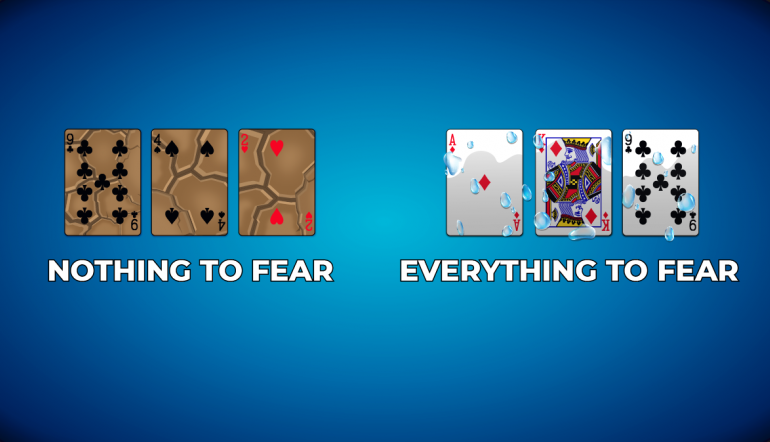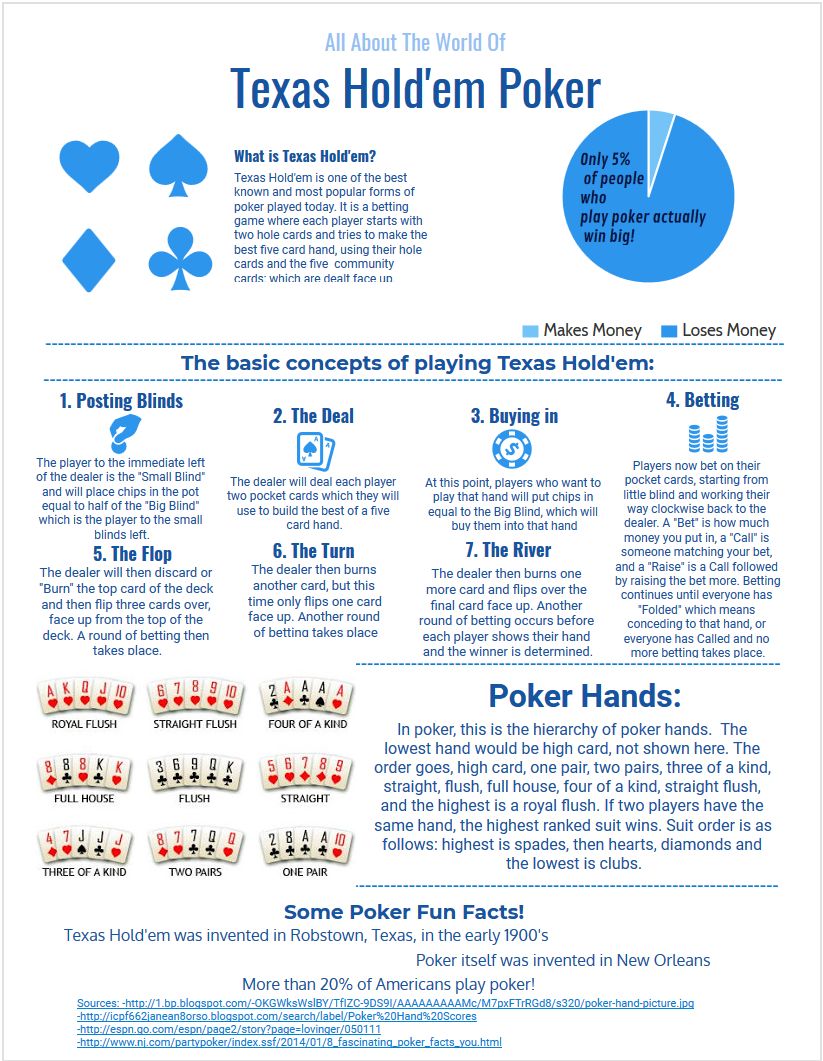Texas Holdem No Limit Betting Rules
- No Limit Betting. No Limit Texas Holdem, or NLHE, is the most common form of Holdem nowadays. The betting rules for NLHE are simple: Raises must be at least twice that of the current bet. For example, if you wanted to make a raise in a $2/$4 game, the minimum raise would be $8. It can be $9, $15 or even $11.25 — it can be whatever you have.
- This guide aims to give you a complete understanding on how Texas Holdem is played, and it will take no longer than 5 minutes. Texas Hold'em rules basics. Texas Holdem is played with a 52-card deck and poker chips. Texas Holdem can be played in a cash game style, where there is no time limit and each hand is played with real money.
In limit Hold'em, the betting amounts are pre-determined and limited to a fixed sum. So, for example, a game could be played with a $2.00 limit. This would mean that all bets (with the exception of.
This article is to help you understand the rules of Texas Hold’Em Betting Rules: No-Limit vs Limit. Let’s get started.
But first, you need to understand how the game is played.
Table position and the blinds
In Hold’Em, position refers to where you sit relative to the dealer button, which determines when it is your turn to act. The dealer button rotates clockwise after every hand.
The big blind and small blind are forced bets that are placed into the pot before any cards are dealt. These bets are designed to elicit action.
The player to the left of the dealeris the small blind and the next player to the leftis the big blind. When the first round of betting ensues, the player to the left of the big blind is the first to act. This player’s position is called “under the gun.”
After the flop, and for each subsequent round of betting, the player in the small blind is the first to act and the player on the dealer button is the last to act, provided neither player has folded.
Texas Hold’Em betting rules
In all versions of Texas Hold’Em, players have three options: check/call, bet/raise, or fold. Checking is simply matching the previous non-bet while calling is simply matching the previous bet. Think of checking as a free call.
Betting involves putting chips into the pot—based on the specific rules to be discussed below—and raising is to increase the amount of a previous bet—again, based on the specific rules to follow.
Finally, folding is to discard one’s hand and wait for the next deal.
Now, let’s take a look at no-limit and limit Texas Hold’Em betting rules.
No-Limit Texas Hold’Em betting rules
No-Limit Texas Hold’Em (NHLE) has gained considerable popularity with players who enjoy the unique combination of luck, skill, chance, and action and the incredible adrenaline rush that comes with placing all of one’s chips in the pot on one hand. One need only look at the increasing number of participants in various NLHE tournaments around the world—especially the World Series of Poker (WSOP) Main Event—to see how popular this game has become.
In NLHE, the minimum bet size is the amount of the big blind. Thus, in a $5/$10 NLHE game, the minimum bet is $10. The maximum bet is a player’s total chip stack.
The minimum raise must equal the previous bet or raise. So, if a player raises to $20 preflop, a subsequent raise must be the previous raise of $20 plus the big blind ($10) for a total of $30. Mind you, this is the minimum raise. Because this is no-limit, there is no maximum limit, so the maximum raise is your total chip stack.
Limit Texas Hold’Em betting rules
In limit, or fixed-limit, Hold’Em, there are two bet sizes:
- The small bet, which is used preflop and on the flop.
- The big bet, which is used on the turn and river.
The big blind is equal to the small bet. So, in a $2/$4 Limit Hold’Em game, the blinds are $1/$2.

Any raise is limited to the size of one bet, and there is a maximum of four bets per round. Putting in the forth bet is called “capping” the bet.
So, for example, a player can raise to $4 preflop, which can then be called or re-raised to $6 by another player. The next player can then re-raise to $8, capping the betting. From that point, the remaining players can only call or fold.
On the turn and river, the bets and raises are double. So if we’re playing $2/$4, the first player can bet $4 and, if the next players wishes to raise, he must make it $8.
Straddle bets
A straddle bet is an optional blind bet made by the player to the immediate left of the big blind. This bet is twice the big blind. Some casinos permit sleeper straddles by other players or button straddles made by the player in the dealer position. The player making the straddle bet has the opportunity to act last preflop as is ordinarily the case with the big blind.
All-in and side pots
Given that players will not all have the same amount of chips, if a player wishes to call a bet or a raise and doesn’t have enough chips, s/he can go all-in. A player can also go all-in if s/he has enough to call the previous bet or raise and wants to raise but doesn’t have enough to constitute a full raise. In these situations, the next player can call or raise based on the all-in bet.
In this case, the dealer creates a side pot. The main pot is comprised of the all-in player’s total chips plus an equal amount from each player who is still in the hand and all of the chips in the pot by those who have already folded. The remaining chips are in the side pot, and the all-in player has no stake in this pot.
If another player goes all-in after creation of this side pot, then another side pot is created. Similarly, the second all-in player has no stake in the third side pot, and so forth.
Texas Hold’Em Poker betting rules etiquette
There are a few words of wisdom of which to take heed when playing any type of Texas Hold’Em.
- Pay attention to the action and do not bet “out of turn.” Not only is betting out of turn rude but it also gives other players who haven’t acted yet more information than those who have already acted.
- Do not angle shoot with string bets or string raises. These actions involve placing chips over the betting line and then getting more chips to add. Players who are notorious for angle shooting do so to gauge the reaction of other players in the hand.
- If you toss a single chip into the pot that is larger than the existing bet without announcing a raise, you are simply calling. If you want to raise, it’s always good practice to announce the amount of the raise before placing any chips into the pot.
- Don’t splash the pot, or throw chips into the pot. Doing so is not only unnecessary and rude but also complicates keeping track of who bet what. If you bet or raise, simply place your chips over the betting line and let the dealer take it from there.
We hope that this little tutorial answered some of your questions about Texas Hold’Em betting rules. Please share any comments below.
Source:@ UpswingPoker
Like all poker games, Hold’em has a very specific order in which the cards are dealt and played.
Hole cards
At the start of a Hold’em hand, after the two blinds have been posted, all players are dealt two cards facedown. These are known as the hole or pocket cards. Players then make a decision to call the blinds (match the big blind), raise the blinds (increase the bet) or fold (quit playing and throw their cards facedown to the middle of the table).
In the form of Hold’em known as Limit, the bets have to be of a certain specified amount. In No-Limit, players may bet any amount of their chips on the table.
If you’re a newbie to the game, you might consider this: If both of your hole cards are not 10s or greater (Jacks, Queens, Kings, or Aces), fold. Yes, it sounds harsh, but it’ll keep you pretty much only playing the cards that you should — and about the right frequency of hands.
Texas Holdem No Limit Betting Rules
Make sure not to show your hole cards to other players at the table (even if those other players are no longer in the hand). And after you’ve looked at your cards, you should protect them from being collected by the dealer by placing an extra poker chip (or some other small object) on top of them.
The flop
After the betting action is done on the round with the hole cards (also known as pre-flop), three cards are displayed by the dealer simultaneously to the center of the poker table — this is known as the flop. At this point, each player at the table has a unique five-card poker hand consisting of his two hole cards and the three community cards.
Because of the raw number of cards involved, the flop typically gives you the general tenor of the poker hand and definitely gives you a good idea of the kind of hand to look for as a winner. For example, an all-Spade flop (especially with a lot of players still in the hand) will be hinting at a flush as a strong possibility for a winner.
Betting begins with the first person still in the hand to the left (clockwise) of the dealer button. As a general rule, you want your hand to match the flop, and you should fold if it doesn’t.
In Limit play, the size of the bet you can make on the flop is identical to the amount you can make pre-flop.

The turn
After the flop betting round is completed, another community card is placed, known as the turn (or sometimes fourth street). Each of the remaining players now has a six-card poker hand made up of his two private hole cards and the four community cards. Hold’em is a game where only five cards count toward a poker hand, so everyone has a theoretical “extra” card at this point.


In Limit, the betting is now twice the amount that was bet pre- and post-flop.
Poker wags like to say, “The turn plays itself,” meaning your hand gets better and you bet it, or it doesn’t and you start giving strong thoughts to folding. This is more or less true.
The river
After the betting round of the turn, a final community card is exposed, known as the river (sometimes called fifth street).
Each player left in the game has his final hand consisting of the best five cards of the seven available (two private hole cards and the five community cards). Players may use two hole cards along with three community cards, one hole card combined with four community cards, or just the five community cards (known as playing the board). Again, poker hands are made up of the best five cards — the other two available to any given player don’t count. There is one final round of betting.
Texas Hold'em No Limit Betting Rules
The showdown
The showdown is what happens after the final river bets have been placed. Although it isn’t formally required, typically the person who initiated the final round of betting is first to show her hand. The action then proceeds in a clockwise fashion with players either mucking their hands if they can’t beat the hand exposed, or showing a better hand (at which point the dealer mucks the old, “worse” hand and continues around the table for any remaining hands).
Winners and losers are determined by the standard poker hand rankings.
If you’re ever unclear about who is winning a hand, just turn your cards face up and let the dealer decide. Never take a player’s word on what she has in hand until you’ve actually seen her cards with your own eyes — when you muck a hand, it’s officially dead.